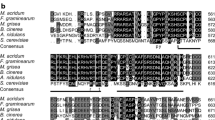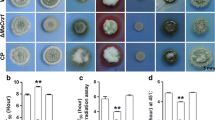Abstract
Flo8/Som1, which functions downstream from the cyclic AMP (cAMP)-dependent protein kinase A (PKA) pathway, plays important roles in hyphal development, spore formation, and virulence in yeast and several filamentous fungi. However, the functions of Som1 in entomopathogenic fungi are still a mystery. In this study, MaSom1, a Flo8/Som1 homolog, was identified and functionally characterized in a model entomopathogenic fungus Metarhizium acridum. Similar to Flo8/Som1 in other fungi, MaSom1 mainly localized to the nucleus in M. acridum. Disruption of MaSom1 reduced conidial yield, delayed conidial germination, and impaired the fungal tolerances to heat and UV-B. The expression levels of some genes involved in defenses of heat shock and UV-B radiation were significantly reduced in ΔMaSom1. MaSom1 is also important for cell wall integrity and conidial surface structures in M. acridum. Some genes related to fungal cell wall synthesis were downregulated in ΔMaSom1. Bioassays showed that ΔMaSom1 had a dramatically decreased virulence after both topical inoculation and intrahemocoel injection of the fungus in locusts. Moreover, inactivation of MaSom1 reduced appressorium formation, diminished fungal growth in locust hemolymph in vitro, and enhanced insect immune responses. Taken together, these results indicate that disruption of MaSom1 leads to a decline of fungal virulence because of impairments in conidial germination and appressorium formation, reduction of fungal growth in host hemolymph, and enhancement of insect immune responses owing to the changes in conidial surface structures.







Similar content being viewed by others
References
Adams TH, Wieser JK, Yu JH (1998) Asexual sporulation in Aspergillus nidulans. Microbiol Mol Biol Rev 62(1):35–54
Aguirre J, Hansberg W, Navarro R (2006) Fungal responses to reactive oxygen species. Med Mycol 44(S1):S101–S107
Beck MH, Strand MR (2007) A novel polydnavirus protein inhibits the insect prophenoloxidase activation pathway. Proc Natl Acad Sci U S A 104(49):19267–19272
Cao F, Lane S, Raniga PP, Lu Y, Zhou Z, Ramon K, Chen J, Liu H (2006) The Flo8 transcription factor is essential for hyphal development and virulence in Candida albicans. Mol Biol Cell 17(1):295–307
Choi YE, Xu JR (2010) The cAMP signaling pathway in Fusarium verticillioides is important for conidiation, plant infection, and stress responses but not fumonisin production. Mol Plant-Microbe Interact 23(4):522–533
dos Reis MC, Pelegrinelli Fungaro MH, Delgado Duarte RT, Furlaneto L, Furlaneto MC (2004) Agrobacterium tumefaciens-mediated genetic transformation of the entomopathogenic fungus Beauveria bassiana. J Microbiol Methods 58(2):197–202
D'Souza CA, Heitman J (2001) Conserved cAMP signaling cascades regulate fungal development and virulence. FEMS Microbiol Rev 25(3):349–364
Emes R, Ponting C (2001) A new sequence motif linking lissencephaly, Treacher collins and oral-facial-digital type 1 syndromes, microtubule dynamics and cell migration. Hum Mol Genet 10(24):2813–2820
Fang W, Pava-ripoll M, Wang S, St Leger R (2009) Protein kinase a regulates production of virulence determinants by the entomopathogenic fungus, Metarhizium anisopliae. Fungal Genet Biol 46(3):277–285
Gao Q, Jin K, Ying S, Zhang Y, Xiao G, Shang Y, Duan Z, Hu X, Xie X, Zhou G, Peng G, Luo Z, Huang W, Wang B, Fang W, Wang S, Zhong Y, Ma L, St Leger RJ, Zhao G, Pei Y, Feng M, Xia Y, Wang C (2011) Genome sequencing and comparative transcriptomics of the model entomopathogenic fungi Metarhizium anisopliae and M. acridum. PLoS Genet 7(1):e1001264
Gold S, Duncan G, Barrett K, Kronstad J (1994) cAMP regulates morphogenesis in the fungal pathogen Ustilago maydis. Genes Dev 8(23):2805–2816
Goldsworthy G, Chandrakant S, Opoku-Ware K (2003) Adipokinetic hormone enhances nodule formation and phenoloxidase activation in adult locusts injected with bacterial lipopolysaccharide. J Insect Physiol 49(8):795–803
Green G, MacQuillan AM (1980) Photorepair of ultraviolet-induced petite mutational damage in Saccharomyces cerevisiae requires the product of the PHR1 gene. J Bacteriol 144(2):826–829
He M, Xia Y (2009) Construction and analysis of a normalized cDNA library from Metarhizium anisopliae var. acridum germinating and differentiating on Locusta migratoria wings. FEMS Microbiol Lett 291(1):127–135
Hu G, St Leger RJ (2002) Field studies using a recombinant mycoinsecticide (Metarhizium anisopliae) reveal that it is rhizosphere competent. Appl Environ Microbiol 68(12):6383–6387
Jenkins GI (2009) Signal transduction in responses to UV-B radiation. Annu Rev Plant Biol 60:407–431
Jin K, Ming Y, Xia YX (2012) MaHog1, a Hog1-type mitogen-activated protein kinase gene, contributes to stress tolerance and virulence of the entomopathogenic fungus Metarhizium acridum. Microbiology 158(12):2987–2996
Jurick Li WM, Rollins JA (2007) Deletion of the adenylate cyclase (sac1) gene affects multiple developmental pathways and pathogenicity in Sclerotina sclerotiorum. Fungal Genet Biol 44(6):521–530
Kim TS, Ahn JY, Yoon JH, Kang HS (2003) STA10 repression of STA gene expression is caused by a defective activator, Flo8, in Saccharomyces cerevisiae. Curr Genet 44(5):261–267
Kim MH, Cooper DR, Oleksy A, Devedjiev Y, Derewenda U, Reiner O, Otlewski J, Derewenda ZS (2004a) The structure of the N-terminal domain of the product of the lissencephaly gene Lis1 and its functional implications. Structure 12(6):987–998
Kim TS, Kim HY, Jin HY, Kang HS (2004b) Recruitment of the Swi/Snf complex by Ste12-Tec1 promotes Flo8-Mss11-mediated activation of STA1 expression. Mol Cell Biol 24(21):9542–9556
Kim HY, Lee SB, Kang HS, Oh GT, Kim T (2014) Two distinct domains of Flo8 activator mediates its role in transcriptional activation and the physical interaction with Mss11. Biochem Biophys Res Commun 449(2):202–207
Kobayashi O, Yoshimoto H, Sone H (1999) Analysis of the genes activated by the Flo8 gene in Saccharomyces cerevisiae. Curr Genet 36(5):256–261
Latgé JP (2007) The cell wall: a carbohydrate armour for the fungal cell. Mol Microbiol 66 (2):279–290
Lazo GR, Stein PA, Ludwig RA (1991) A DNA transformation competent Arabidopsis genomic library in Agrobacterium. Biotechnology 9(10):963–967
Lin CJ, Sasse C, Gerke J, Valerius O, Irmer H, Frauendorf H, Heinekamp T, Straßburger M, Tran VT, Herzog B, Braus-Stromeyer SA, Braus GH (2015) Transcription factor SomA is required for adhesion, development and virulence of the human pathogen Aspergillus fumigatus. PLoS Pathog 11(11):e1005205
Liu H, Styles CA, Fink GR (1996) Saccharomyces cerevisiae S288C has a mutation in Flo8, a gene required for filamentous growth. Genetics 144(3):967–978
Liu S, Peng G, Xia Y (2012) The adenylate cyclase gene MaAC is required for virulence and multi-stress tolerance of Metarhizium acridum. BMC Microbiol 12(1):1–10
Lomer CJ, Bateman RP, Johnson DL, Langewald J, Thomas M (2001) Biological control of locusts and grasshoppers. Annu Rev Entomol 46(1):667–702
Loser K, Weltring K (1998) Induction of a polyubiquitin gene (ubi1) by potato phytoalexins and heat shock in Gibberella pulicaris. Curr Genet 34(5):404–409
Mitchell TK, Dean RA (1995) The cAMP-dependent protein kinase catalytic subunit is required for appressorium formation and pathogenesis by the rice blast pathogen Magnaporthe grisea. Plant Cell 7(11):1869–1878
Nikawa J, Sass P, Wigler M (1987) Cloning and characterization of the low affinity cyclic AMP phosphodiesterase gene of Saccharomyces cerevisiae. Mol Cell Biol 7(10):3629–3636
Ortiz-Urquiza A, Luo Z, Keyhani NO (2015) Improving mycoinsecticides for insect biological control. Appl Microbiol Biotechnol 99(3):1057–1068
Pan X, Heitman J (2002) Protein kinase a operates a molecular switch that governs yeast pseudohyphal differentiation. Mol Cell Biol 22(12):3981–3993
Peng GX, Xie L, Hu J, Xia YX (2009) Identification of genes that are preferentially expressed in conidiogenous cell development of Metarhizium anisopliae by suppression subtractive hybridization. Curr Genet 55(3):263–271
Rangel DE, Braga GU, Flint SD, Anderson AJ, Roberts DW (2004) Variations in UV-B tolerance and germination speed of Metarhizium anisopliae conidia produced on insects and artificial substrates. J Invertebr Pathol 87(2–3):77–83
Roberts DW, Humber RA (1981) Entomogenous fungi. In: Cole GT, Kendrick B (eds) Biology of conidial fungi. Academic Press, New York, pp 201–236
Rupp S, Summers E, Lo HJ, Madhani H, Fink G (1999) MAP kinase and cAMP filamentation signaling pathways converge on the unusually large promoter of the yeast Flo11 gene. EMBO J 18(5):1257–1269
Ryan O, Boone C (2012) Global gene deletion analysis exploring yeast filamentous growth. Science 337(6100):1353–1356
Shapiro RS, Ryan O, Boone C, Cowen LE (2012) Regulatory circuitry governing morphogenesis in Saccharomyces cerevisiae and Candida albicans. Cell Cycle 11(23):4294–4295
St Leger RJ (2008) Studies on adaptations of Metarhizium anisopliae, to life in the soil. J Invertebr Pathol 98(3):271–276
Takano Y, Komeda K, Kojima K, Okuno T (2001) Proper regulation of cyclic AMP-dependent protein kinase is required for growth, conidiation, and appressorium function in the anthracnose fungus Colletotrichum lagenarium. Mol Plant-Microbe Interact 14(10):1149–1157
Tang QY, Feng MG (2007) DPS data processing system: experimental design, statistical analysis and data mining. Science Press, Beijing
Teunissen AWRH, Steensma HY (1995) The dominant flocculation genes of Saccharomyces cerevisiae constitute a new subtelomeric gene family. Yeast 11(11):10011013
Thomas MB, Read AF (2007) Fungal bioinsecticide with a sting. Nat Biotechnol 25(12):1367–1368
Verma S, Idnurm A (2013) The Uve1 endonuclease is regulated by the white collar complex to protect Cryptococcus neoformans from UV damage. PLoS Genet 9(9):e1003769
Wanchoo A, Lewis MW, Keyhani NO (2009) Lectin mapping reveals stage-specific display of surface carbohydrates in vitro and haemolymph-derived cells of the entomopathogenic fungus Beauveria bassiana. Microbiology 155(9):3121–3133
Wang CS, St Leger RJ (2006) A collagenous protective coat enables Metarhizium anisopliae to evade insect immune responses. Proc Natl Acad Sci U S A 103(17):6647–6652
Wang C, St Leger RJ (2007) The Metarhizium anisopliae perilipin homolog MPL1 regulates lipid metabolism, appressorial turgor pressure, and virulence. J Biol Chem 282(29):21110–21115
Xu JR, Urban M, Sweigard JA, Hamer JE (1997) The CPKA gene of Magnaporthe grisea is essential for appressorial penetration. Mol Plant-Microbe Interact 10(2):187–194
Yamashita I, Fukui S (1983) Mating signals control expression of both starch fermentation genes and a novel flocculation gene Flo8 in the yeast Saccharomyces. Agric Biol Chem 47(12):2889–2896
Yan X, Li Y, Yue XF, Wang CC, Que YW, Kong DD, Ma ZH, Talbot NJ, Wang ZY (2011) Two novel transcriptional regulators are essential for infection-related morphogenesis and pathogenicity of the rice blast fungus Magnaporthe oryzae. PLoS Pathog 7(12):e1002385
Zhang Q, Peng G, Wang Z, Yin Y, Xia Y (2005) Detection of Metarhizium anisopliae rDNA in haemalymph of infected adult locust by real-time fluorescence quantitative PCR. Chin Prog. Biotech 25(11):71–75
Zhang SZ, Peng GX, Xia YX (2010) Microcycle conidiation and the conidial properties in the entomopathogenic fungus Metarhizium acridum on agar medium. Biocontrol Sci Tech 20 (8):809–819
Zhang X, St Leger RJ, Fang W (2017) Pyruvate accumulation is the first line of cell defense against heat stress in a fungus. MBio 8(5):e01284–e01217
Funding
This work was supported by the Natural Science Foundation of China (no. 31471820), the Natural Science Foundation Project of Chongqing (CSTC 2015JCYJA80037), and the Fundamental Research Funds for the Central Universities (106112017CDJQJ298831).
Author information
Authors and Affiliations
Corresponding authors
Ethics declarations
Conflict of interest
The authors declare that they have no conflict of interest.
Ethical approval
This article does not contain any studies with human participants performed by any of the authors.
Electronic supplementary material
ESM 1
(PDF 219 kb)
Rights and permissions
About this article
Cite this article
Du, Y., Jin, K. & Xia, Y. Involvement of MaSom1, a downstream transcriptional factor of cAMP/PKA pathway, in conidial yield, stress tolerances, and virulence in Metarhizium acridum. Appl Microbiol Biotechnol 102, 5611–5623 (2018). https://doi.org/10.1007/s00253-018-9020-7
Received:
Revised:
Accepted:
Published:
Issue Date:
DOI: https://doi.org/10.1007/s00253-018-9020-7




